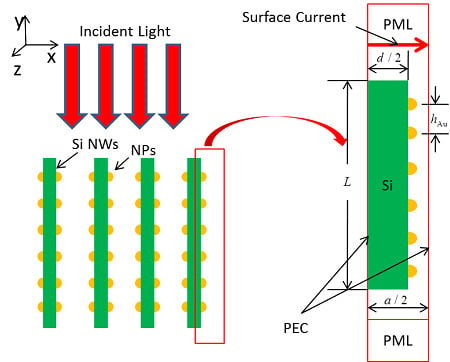Current Approach in Surface Plasmons for Thin Film and Wire Array Solar Cell Applications
Abstract
:1. Introduction
2. Surface Plasmonics in Thin Film Solar Cells
2.1. Plasmonic Nanoparticle-Based Thin Film Solar Cells
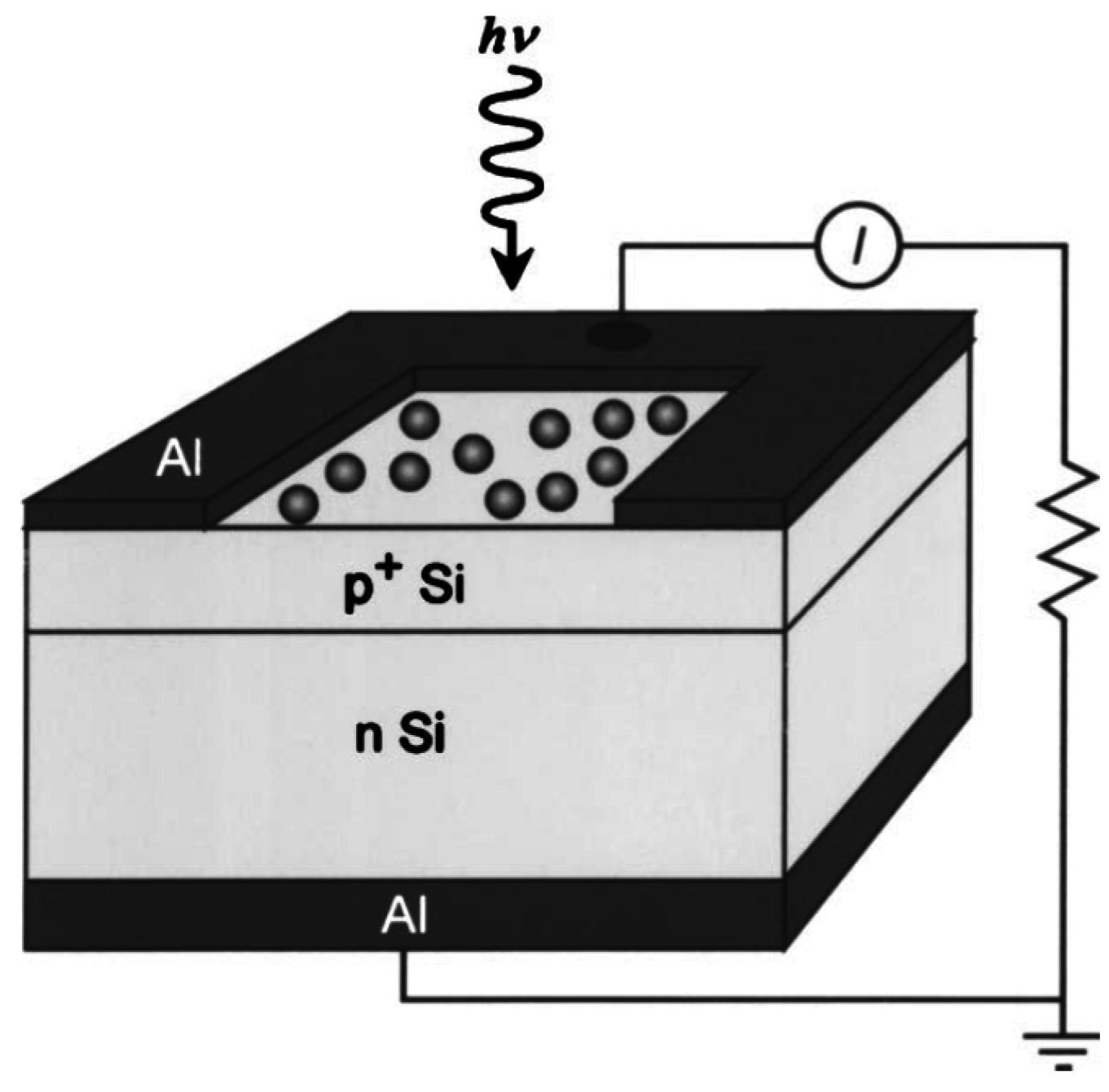
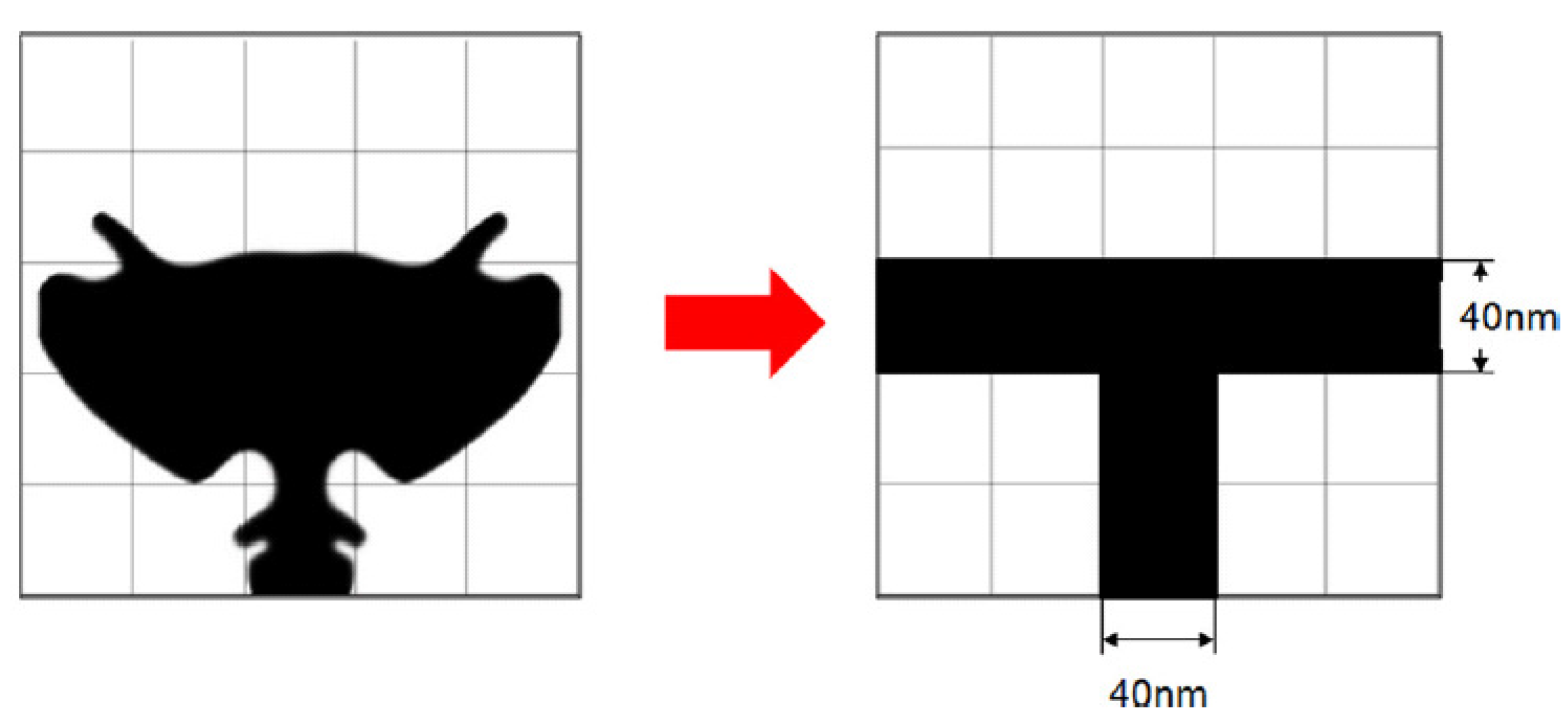
2.2. Plasmonic Nanostructure-Based Thin Film Solar Cells
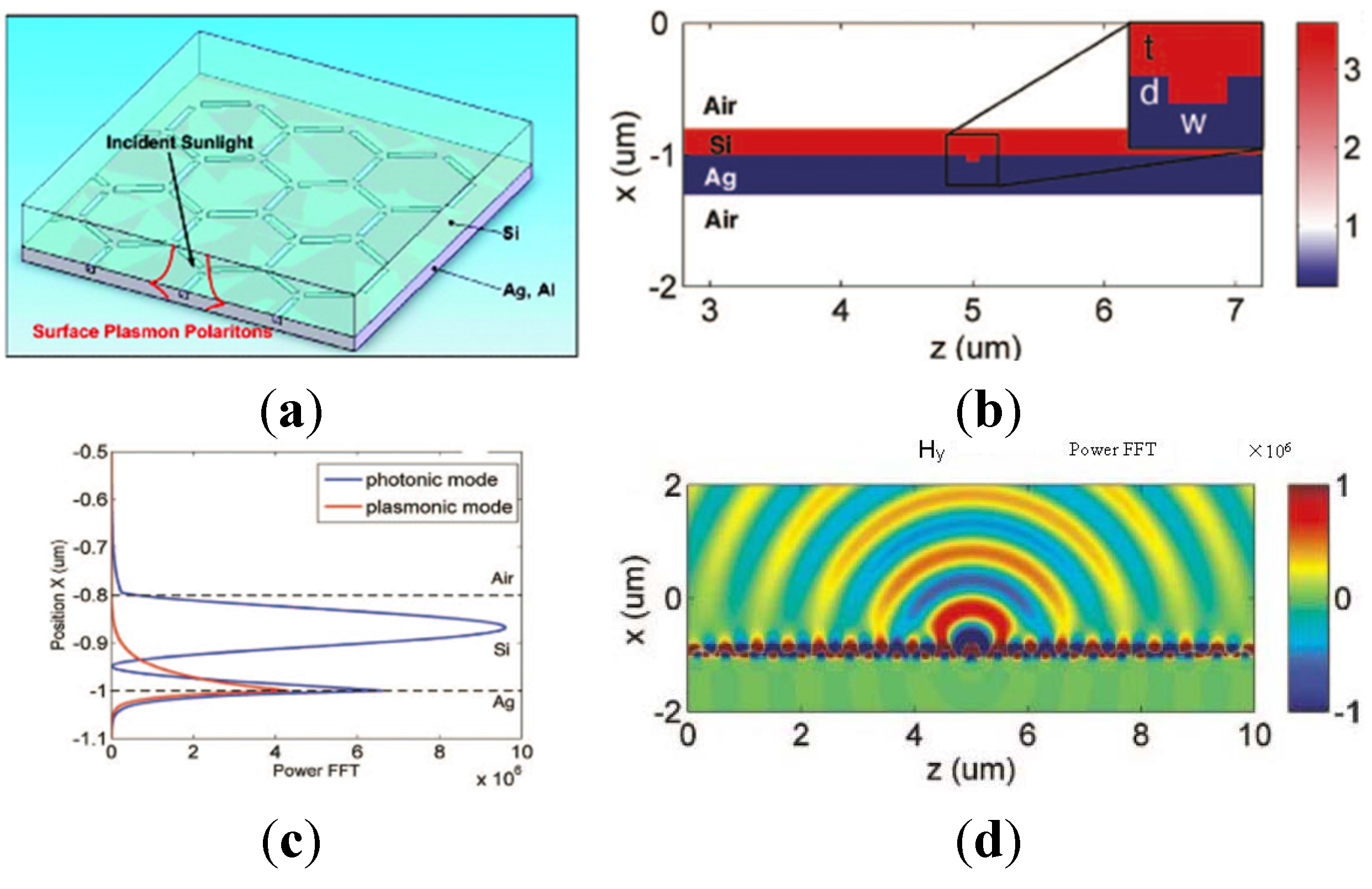

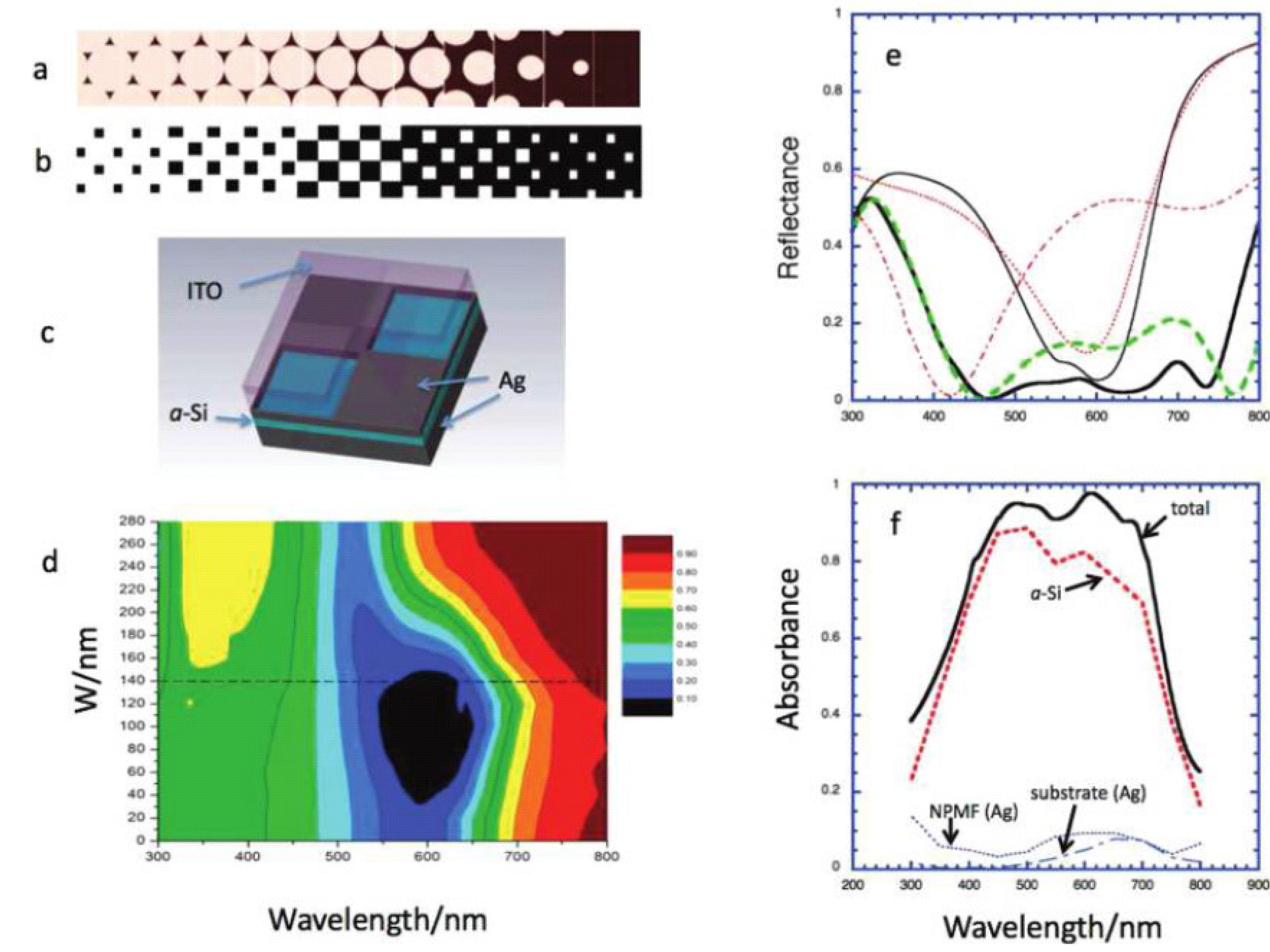
3. Surface Plasmonics in Wire-Array Solar Cells
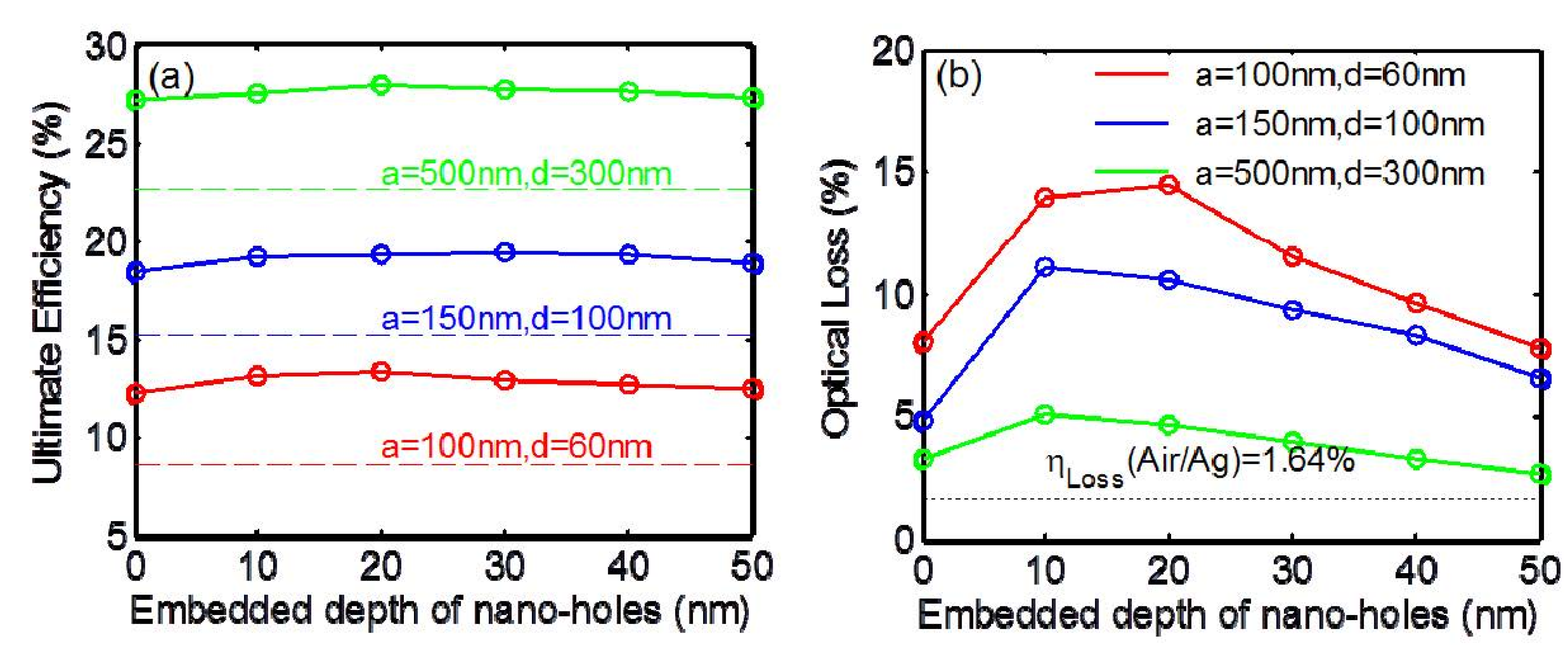

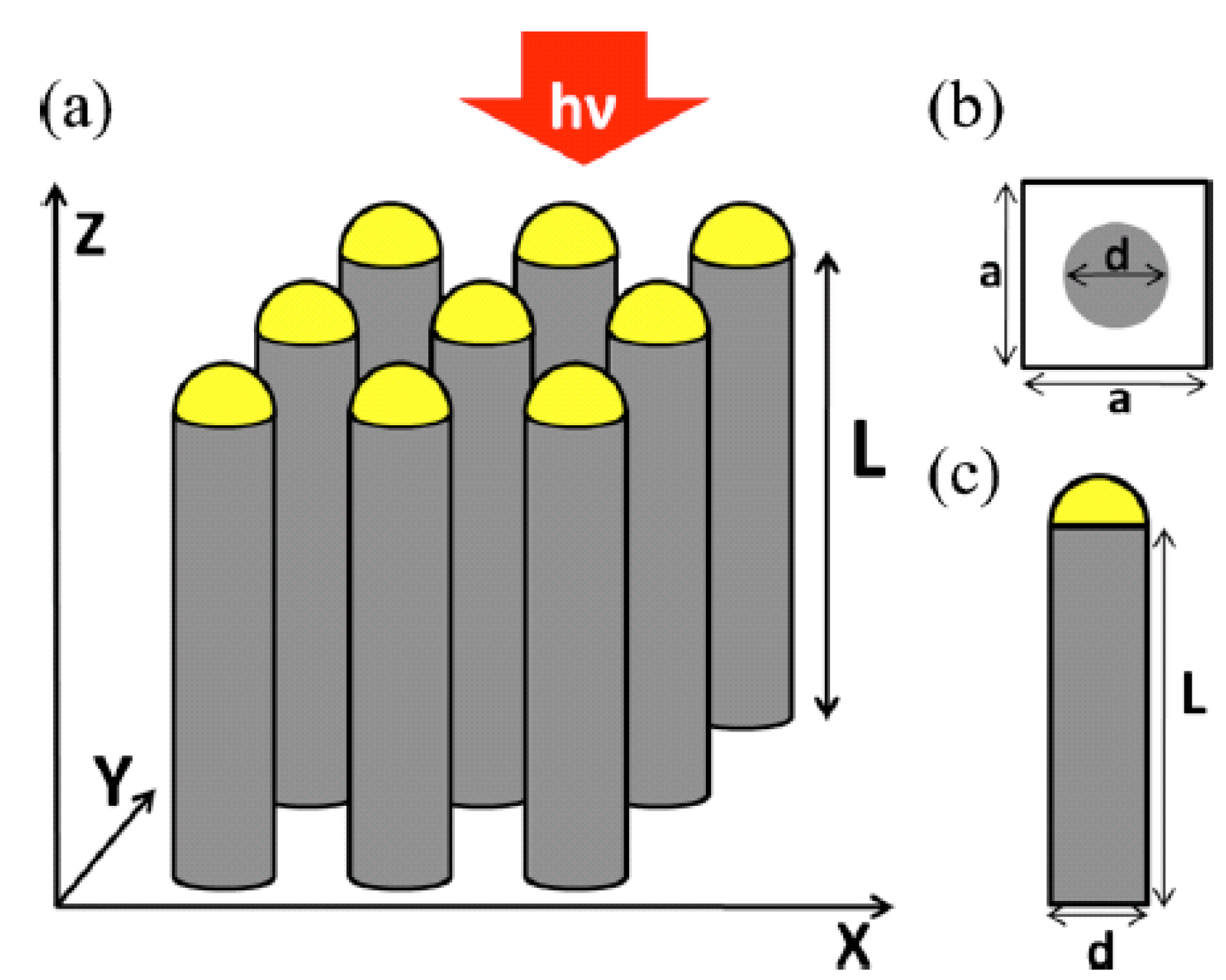
4. Surface Plasmonics in Single Nanowire Solar Cells
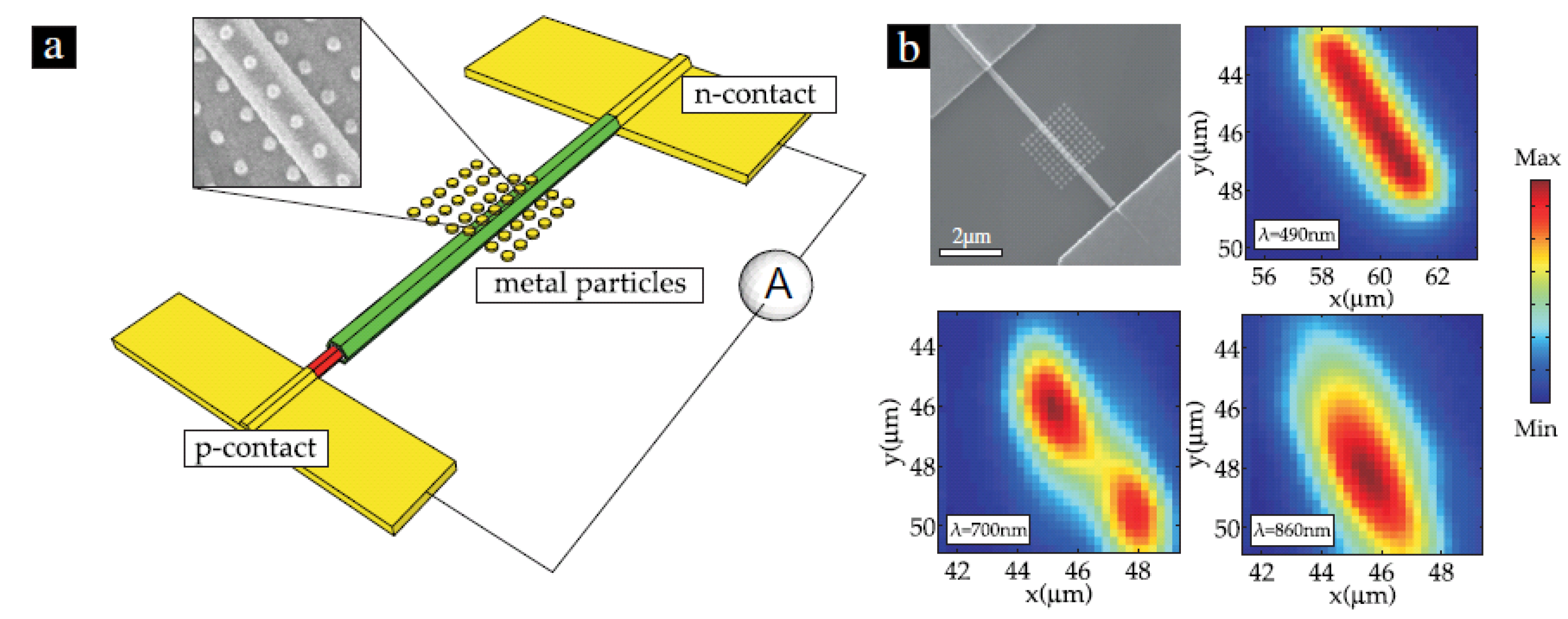
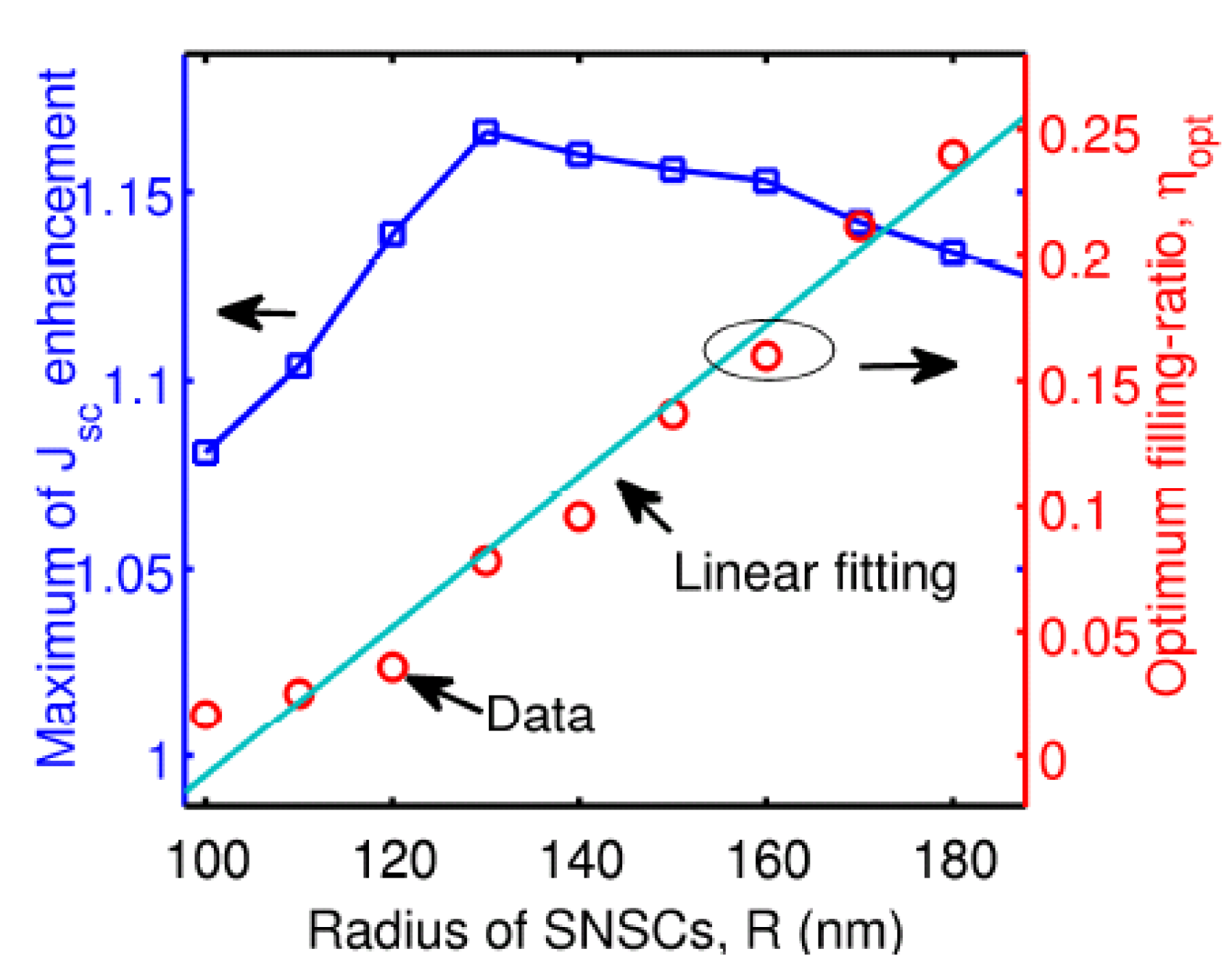
5. Surface Plasmonics-Induced Hot-Electron Generation
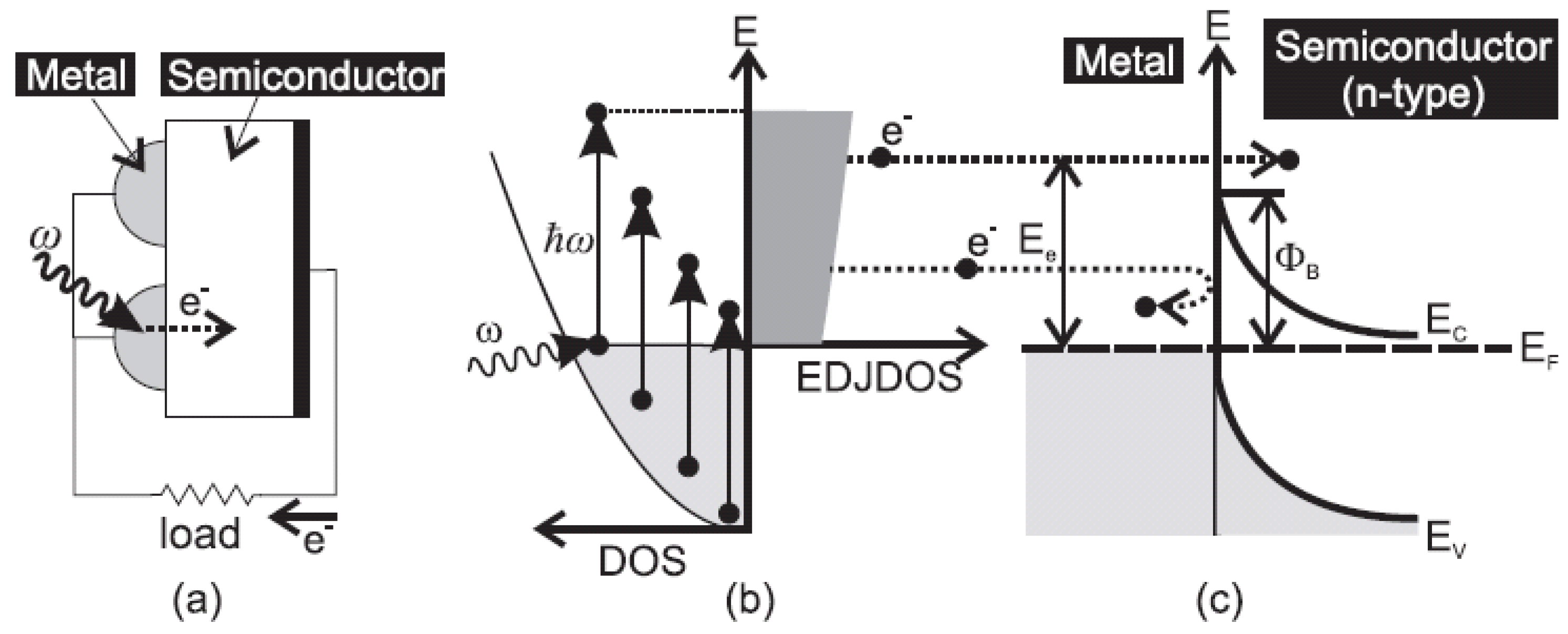
6. Conclusions
Acknowledgments
Author Contributions
Conflicts of Interest
References
- Wood, R.W. On a remarkable case of uneven distribution of light in a diffraction grating spectrum. Philos. Mag. 1902, 4, 396–406. [Google Scholar] [CrossRef]
- Mie, G. Beiträge zur Optik trüber Medien, speziell kolloidaler Metallösungen. Ann. Phys. 1908, 330, 377–445. (In German) [Google Scholar] [CrossRef]
- Ritchie, R.H. Plasma losses by fast electrons in thin films. Phys. Rev. 1957, 106. [Google Scholar] [CrossRef]
- Wang, Y.; Plummer, E.W.; Kempa, K. Foundations of plasmonics. Adv. Phys. 2011, 60, 799–898. [Google Scholar] [CrossRef]
- Hayashi, S.; Okamoto, T. Plasmonics: Visit the past to know the future. J. Phys. D Appl. Phys. 2012, 45, 433001. [Google Scholar] [CrossRef]
- Andrew, P.; Barnes, W.L. Energy transfer across a metal film mediated by surface plasmon polaritons. Science 2004, 306, 1002–1005. [Google Scholar] [CrossRef] [PubMed]
- Stockman, M.I. Nanofocusing of optical energy in tapered plasmonic waveguides. Phys. Rev. Lett. 2004, 93, 137404. [Google Scholar] [CrossRef] [PubMed]
- Mühlschlegel, P.; Eisler, H.J.; Martin, O.J.F.; Hecht, B.; Pohl, D.W. Resonant optical antennas. Science 2005, 308, 1607–1609. [Google Scholar] [CrossRef] [PubMed]
- Krasavin, A.V.; Zheludev, N.I. Active plasmonics: Controlling signals in Au/Ga waveguide using nanoscale structural transformations. Appl. Phys. Lett. 2004, 84, 1416–1418. [Google Scholar] [CrossRef]
- Colombelli, R.; Srinivasan, K.; Troccoli, M.; Painter, O.; Gmachl, C.F.; Tennant, D.M.; Sergent, A.M.; Sivco, D.L.; Cho, A.Y.; Capasso, F. Quantum cascade surface-emitting photonic crystal laser. Science 2003, 302, 1374–1377. [Google Scholar] [CrossRef] [PubMed]
- Pendry, J.B. Negative refraction makes a perfect lens. Phys. Rev. Lett. 2000, 85. [Google Scholar] [CrossRef]
- Shelby, R.A.; Smith, D.R.; Schultz, S. Experimental verification of a negative index of refraction. Science 2001, 292, 77–79. [Google Scholar] [CrossRef] [PubMed]
- Schaadt, D.M.; Feng, B.; Yu, E.T. Enhanced semiconductor optical absorption via surface plasmon excitation in metal nanoparticles. Appl. Phys. Lett. 2005, 86, 063106. [Google Scholar] [CrossRef]
- Atwater, H.A.; Polman, A. Plasmonics for improved photovoltaic devices. Nat. Mater. 2010, 9, 205–213. [Google Scholar] [CrossRef] [PubMed]
- Catchpole, K.R.; Mokkkapati, S.; Beck, F.; Wang, E.C.; McKinley, A.; Basch, A.; Lee, J. Plasmonics and nanophotonics for photovoltaics. MRS Bull. 2011, 36, 461–467. [Google Scholar] [CrossRef]
- Ferry, V.E.; Munday, J.N.; Atwater, H.A. Design considerations for plasmonic photovoltaics. Adv. Mater. 2010, 22, 4794–4808. [Google Scholar] [CrossRef] [PubMed]
- Green, M.A.; Pillai, S. Harnessing plasmonics for solar cells. Nat. Photonics 2012, 6, 130–132. [Google Scholar] [CrossRef]
- Pillai, S.; Green, M.A. Plasmonics for photovoltaic applications. Sol. Energy Mater. Sol. Cells 2010, 94, 1481–1486. [Google Scholar] [CrossRef]
- Zeman, M.; Isabella, O.; Jäger, K.; Santbergen, R.; Solntsev, S.; Topic, M.; Krc, J. Advanced light management approaches for thin-film silicon solar cells. Energy Procedia 2012, 15, 189–199. [Google Scholar] [CrossRef]
- Pillai, S.; Catchpole, K.R.; Trupke, T.; Green, M.A. Surface plasmon enhanced silicon solar cells. J. Appl. Phys. 2007, 101. [Google Scholar] [CrossRef]
- Catchpole, K.R.; Polman, A. Design principles for particle plasmon enhanced solar cells. Appl. Phys. Lett. 2008, 93. [Google Scholar] [CrossRef]
- Akimov, Y.A.; Ostrikov, K.; Li, E.P. Surface plasmon enhancement of optical absorption in thin-film silicon solar cells. Plasmonics 2009, 4, 107–113. [Google Scholar] [CrossRef]
- Sreekanth, K.V.; Sidharthan, R.; Murukeshan, V.M. Gap modes assisted enhanced broadband light absorption in plasmonic thin film solar cell. J. Appl. Phys. 2011, 110. [Google Scholar] [CrossRef]
- Xu, R.; Wang, X.; Song, L.; Liu, W.; Ji, A.; Yang, F.; Li, J. Influence of the light trapping induced by surface plasmons and antireflection film in crystalline silicon solar cells. Opt. Express 2012, 20, 5061–5068. [Google Scholar] [CrossRef] [PubMed]
- Akimov, Y.A.; Koh, W.S.; Ostrikov, K. Enhancement of optical absorption in thin-film solar cells through the excitation of higher-order nanoparticle plasmon modes. Opt. Express 2009, 17, 10195–10205. [Google Scholar] [CrossRef] [PubMed]
- Spinelli, P.; Hebbink, M.; De Waele, R.; Black, L.; Lenzmann, F.; Polman, A. Optical impedance matching using coupled plasmonic nanoparticle arrays. Nano Lett. 2011, 11, 1760–1765. [Google Scholar] [CrossRef] [PubMed]
- Byun, S.; Lee, H.Y.; Yoo, J. Systematic approach of nanoparticle design to enhance the broadband plasmonic scattering effect. J. Appl. Phys. 2014, 115. [Google Scholar] [CrossRef]
- Varlamov, S.; Rao, J.; Soderstrom, T. Polycrystalline silicon thin-film solar cells with plasmonic-enhanced light-trapping. J. Vis. Exp. 2012. [Google Scholar] [CrossRef] [PubMed]
- Park, J.; Rao, J.; Kim, T.; Varlamov, S. Highest efficiency plasmonic polycrystalline silicon thin-film solar cells by optimization of plasmonic nanoparticle fabrication. Plasmonics 2013, 8, 1209–1219. [Google Scholar] [CrossRef]
- Stratakis, E.; Kymakis, E. Nanoparticle-based plasmonic organic photovoltaic devices. Mater. Today 2013, 16, 133–146. [Google Scholar] [CrossRef]
- Westphalen, M.; Kreibig, U.; Rostalski, J.; Lüth, H.; Meissner, D. Metal cluster enhanced organic solar cells. Sol. Energy Mater. Sol. Cells 2000, 61, 97–105. [Google Scholar] [CrossRef]
- Morfa, A.J.; Rowlen, K.L.; Reilly, T.H.; Romero, M.J.; van de Lagemaat, J. Plasmon-enhanced solar energy conversion in organic bulk heterojunction photovoltaics. Appl. Phys. Lett. 2008, 92. [Google Scholar] [CrossRef]
- Wu, B.; Liu, X.; Oo, T.Z.; Xing, G.; Mathews, N.; Sum, T.C. Resonant aluminum nanodisk array for enhanced tunable broadband light trapping in ultrathin bulk heterojunction organic photovoltaic devices. Plasmonics 2012, 7, 677–684. [Google Scholar] [CrossRef]
- Yoon, W.J.; Jung, K.Y.; Liu, J.; Duraisamy, T.; Revur, R.; Teixeira, F.L.; Sengupta, S.; Berger, P.R. Plasmon-enhanced optical absorption and photocurrent in organic bulk heterojunction photovoltaic devices using self-assembled layer of silver nanoparticles. Sol. Energy Mater. Sol. Cells 2010, 94, 128–132. [Google Scholar] [CrossRef]
- Ravi, A.; Luthra, A.; Teixeira, F.L.; Berger, P.R.; Coe, J.V. Tuning the plasmonic extinction resonances of hexagonal arrays of Ag nanoparticles. Plasmonics 2015. [Google Scholar] [CrossRef]
- Wang, D.H.; Kim, J.K.; Lim, G.H.; Park, K.H.; Park, O.O.; Lim, B.; Park, J.H. Enhanced light harvesting in bulk heterojunction photovoltaic devices with shape-controlled Ag nanomaterials: Ag nanoparticles versus Ag nanoplates. RSC Adv. 2012, 2, 7268–7272. [Google Scholar] [CrossRef]
- Kim, C.H.; Cha, S.H.; Kim, S.C.; Song, M.; Lee, J.; Shin, W.S.; Moon, S.J.; Bahng, J.H.; Kotov, N.A.; Jin, S.H. Silver nanowire embedded in P3HT:PCBM for high-efficiency hybrid photovoltaic device applications. ACS Nano 2011, 5, 3319–3325. [Google Scholar] [CrossRef] [PubMed]
- Ferry, V.E.; Sweatlock, L.A.; Pacifici, D.; Atwater, H.A. Plasmonic nanostructure design for efficient light coupling into solar cells. Nano Lett. 2008, 8, 4391–4397. [Google Scholar] [CrossRef] [PubMed]
- Pala, R.A.; White, J.; Barnard, E.; Liu, J.; Brongersma, M.L. Design of plasmonic thin-film solar cells with broadband absorption enhancements. Adv. Mater. 2009, 21, 3504–3509. [Google Scholar] [CrossRef]
- Munday, J.N.; Atwater, H.A. Large integrated absorption enhancement in plasmonic solar cells by combining metallic gratings and antireflection coatings. Nano Lett. 2011, 11, 2195–2201. [Google Scholar] [CrossRef] [PubMed]
- Paetzold, U.W.; Meier, M.; Moulin, E.; Smirnov, V.; Pieters, B.E.; Rau, U.; Carius, R. Plasmonic back contacts with non-ordered Ag nanostructures for light trapping in thin-film silicon solar cells. Mater. Sci. Eng. B 2013, 178, 630–634. [Google Scholar] [CrossRef]
- Wang, Y.; Sun, T.; Paudel, T.; Zhang, Y.; Ren, Z.; Kempa, K. Metamaterial-plasmonic absorber structure for high efficiency amorphous silicon solar cells. Nano Lett. 2012, 12, 440–445. [Google Scholar] [CrossRef] [PubMed]
- Springer, J.; Poruba, A.; Müllerova, L.; Vanecek, M.; Kluth, O.; Rech, B. Absorption loss at nanorough silver back reflector of thin-film silicon solar cells. J. Appl. Phys. 2004, 95, 1427–1429. [Google Scholar] [CrossRef]
- Paetzold, U.W.; Hallermann, F.; Pieters, B.E.; Rau, U.; Carius, R.; Von Plessen, G. Localized plasmonic losses at metal back contacts of thin-film silicon solar cells. Proc. SPIE 2010, 7725. [Google Scholar] [CrossRef]
- Feltrin, A.; Meguro, T.; Ichikawa, M.; Sezaki, F.; Yamamoto, K. Light scattering and parasitic absorption in thin film silicon solar cells containing metal nanoparticles. J. Photonics Energy 2011, 1. [Google Scholar] [CrossRef]
- Peng, K.; Xu, Y.; Wu, Y.; Yan, Y.; Lee, S.T.; Zhu, J. Aligned single-crystalline Si nanowire arrays for photovoltaic applications. Small 2005, 1, 1062–1067. [Google Scholar] [CrossRef] [PubMed]
- Garnett, E.C.; Brongersma, M.L.; Cui, Y.; McGehee, M.D. Nanowire solar cells. Annu. Rev. Mater. Res. 2011, 41, 269–295. [Google Scholar] [CrossRef]
- Kelzenberg, M.D.; Turner-Evans, D.B.; Putnam, M.C.; Boettcher, S.W.; Briggs, R.M.; Baek, J.Y.; Lewis, N.S.; Atwater, H.A. High-performance Si microwire photovoltaics. Energy Environ. Sci. 2011, 4, 866–871. [Google Scholar] [CrossRef]
- Song, T.; Lee, S.T.; Sun, B. Silicon nanowires for photovoltaic applications: The progress and challenge. Nano Energy 2012, 1, 654–673. [Google Scholar] [CrossRef]
- Sivakov, V.; Andrä, G.; Gawlik, A.; Berger, A.; Plentz, J.; Falk, F.; Christiansen, S.H. Silicon nanowire-based solar cells on glass: Synthesis, optical properties, and cell parameters. Nano Lett. 2009, 9, 1549–1554. [Google Scholar] [CrossRef] [PubMed]
- Jia, G.; Andrä, G.; Gawlik, A.; Schönherr, S.; Plentz, J.; Eisenhawer, B.; Pliewischkies, T.; Dellith, A.; Falk, F. Nanotechnology enhanced solar cells prepared on laser-crystallized polycrystalline thin films (< 10 μm). Sol. Energy Mater. Sol. Cells 2014, 126, 62–67. [Google Scholar]
- Hu, L.; Chen, G. Analysis of optical absorption in silicon nanowire arrays for photovoltaic applications. Nano Lett. 2007, 7, 3249–3252. [Google Scholar] [CrossRef] [PubMed]
- Putnam, M.C.; Boettcher, S.W.; Kelzenberg, M.D.; Turner-Evans, D.B.; Spurgeon, J.M.; Warren, E.L.; Briggs, R.M.; Lewis, N.S.; Atwater, H.A. Si microwire-array solar cells. Energy Environ. Sci. 2010, 3, 1037–1041. [Google Scholar] [CrossRef]
- Park, K.T.; Guo, Z.; Um, H.D.; Jung, J.Y.; Yang, J.M.; Lim, S.K.; Kim, Y.S.; Lee, J.H. Optical properties of Si microwires combined with nanoneedles for flexible thin film photovoltaics. Opt. Express 2011, 19, A41–A50. [Google Scholar] [CrossRef] [PubMed]
- Zhou, K.; Guo, Z.; Li, X.; Jung, J.Y.; Jee, S.W.; Park, K.T.; Um, H.D.; Wang, N.; Lee, J.H. The tradeoff between plasmonic enhancement and optical loss in silicon nanowire solar cells integrated in a metal back reflector. Opt. Express 2012, 20, A777–A787. [Google Scholar] [CrossRef] [PubMed]
- Lee, E.; Zhou, K.; Gwon, M.; Jung, J.Y.; Lee, J.H.; Kim, D.W. Beneficial roles of Al back reflectors in optical absorption of Si nanowire array solar cells. J. Appl. Phys. 2013, 114. [Google Scholar] [CrossRef]
- Lin, C.; Povinelli, M.L. The effect of plasmonic particles on solar absorption in vertically aligned silicon nanowire arrays. Appl. Phys. Lett. 2010, 97. [Google Scholar] [CrossRef]
- Zhou, K.; Jee, S.W.; Guo, Z.; Liu, S.; Lee, J.H. Enhanced absorptive characteristics of metal nanoparticle-coated silicon nanowires for solar cell applications. Appl. Optics 2011, 50, G63–G68. [Google Scholar] [CrossRef] [PubMed]
- Kelzenberg, M.D.; Boettcher, S.W.; Petykiewicz, J.A.; Turner-Evans, D.B.; Putnam, M.C.; Warren, E.L.; Spurgeon, J.M.; Briggs, R.M.; Lewis, N.S.; Atwater, H.A. Enhanced absorption and carrier collection in Si wire arrays for photovoltaic applications. Nat. Mater. 2010, 9, 239–244. [Google Scholar] [CrossRef] [PubMed]
- Garnett, E.; Yang, P. Silicon nanowire radial p–n junction solar cells. J. Am. Chem. Soc. 2008, 130, 9224–9225. [Google Scholar] [CrossRef] [PubMed]
- Cao, L.; Fan, P.; Brongersma, M.L. Optical coupling of deep-subwavelength semiconductor nanowires. Nano Lett. 2011, 11, 1463–1468. [Google Scholar] [CrossRef] [PubMed]
- Tian, B.; Kempa, T.J.; Lieber, C.M. Single nanowire photovoltaics. Chem. Soc. Rev. 2009, 38, 16–24. [Google Scholar] [CrossRef] [PubMed]
- Brittman, S.; Gao, H.; Garnett, E.C.; Yang, P. Absorption of light in a single-nanowire silicon solar cell decorated with an octahedral silver nanocrystal. Nano Lett. 2011, 11, 5189–5195. [Google Scholar] [CrossRef] [PubMed]
- Colombo, C.; Krogstrup, P.; Nygård, J.; Brongersma, M.L.; i Morral, A.F. Engineering light absorption in single-nanowire solar cells with metal nanoparticles. New J. Phys. 2011, 13. [Google Scholar] [CrossRef]
- Robak, E.; Grześkiewicz, B.; Kotkowiak, M. Absorption enhancement in silicon nanowire-optical nanoantenna system for photovoltaic applications. Opt. Mater. 2014, 37, 104–109. [Google Scholar] [CrossRef]
- Zhan, Y.; Zhao, J.; Zhou, C.; Alemayehu, M.; Li, Y.; Li, Y. Enhanced photon absorption of single nanowire α-Si solar cells modulated by silver core. Opt. Express 2012, 20, 11506–11516. [Google Scholar] [CrossRef] [PubMed]
- Shi, L.; Zhon, Z.; Huang, Z. The influence of silver core position on enhanced photon absorption of single nanowire α-Si solar cells. Opt. Express 2013, 21, A1007–A1017. [Google Scholar] [CrossRef] [PubMed]
- Semenov, A.D.; Gol’tsman, G.N.; Sobolewski, R. Hot-electron effect in superconductors and its applications for radiation sensors. Supercond. Sci. Technol. 2002, 15. [Google Scholar] [CrossRef]
- Clavero, C. Plasmon-induced hot-electron generation at nanoparticle/metal-oxide interfaces for photovoltaic and photocatalytic devices. Nat. Photonics 2014, 8, 95–103. [Google Scholar] [CrossRef]
- White, T.P.; Catchpole, K.R. Plasmon-enhanced internal photoemission for photovoltaics: Theoretical efficiency limits. Appl. Phys. Lett. 2012, 101. [Google Scholar] [CrossRef]
© 2015 by the authors; licensee MDPI, Basel, Switzerland. This article is an open access article distributed under the terms and conditions of the Creative Commons Attribution license (http://creativecommons.org/licenses/by/4.0/).
Share and Cite
Zhou, K.; Guo, Z.; Liu, S.; Lee, J.-H. Current Approach in Surface Plasmons for Thin Film and Wire Array Solar Cell Applications. Materials 2015, 8, 4565-4581. https://doi.org/10.3390/ma8074565
Zhou K, Guo Z, Liu S, Lee J-H. Current Approach in Surface Plasmons for Thin Film and Wire Array Solar Cell Applications. Materials. 2015; 8(7):4565-4581. https://doi.org/10.3390/ma8074565
Chicago/Turabian StyleZhou, Keya, Zhongyi Guo, Shutian Liu, and Jung-Ho Lee. 2015. "Current Approach in Surface Plasmons for Thin Film and Wire Array Solar Cell Applications" Materials 8, no. 7: 4565-4581. https://doi.org/10.3390/ma8074565
APA StyleZhou, K., Guo, Z., Liu, S., & Lee, J.-H. (2015). Current Approach in Surface Plasmons for Thin Film and Wire Array Solar Cell Applications. Materials, 8(7), 4565-4581. https://doi.org/10.3390/ma8074565





